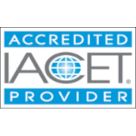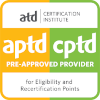Product Details
Topics Covered
- Online learning
- Trends in online learning
- Constructivist model
- Transmission model
- Active learning
- Course development process
- Learning objectives
- Bloom's Taxonomy
- Blended learning
- Adult learner needs
- Whole-Part-Whole
- Worked examples
- Instructional scaffolding
- 5E Learning Model
- Online learning variety
- Incorporating video
- Success measurement
Key Features
- Mobile-friendly
- Audio-enabled
- Badge and credit-awarding
- Real-world case studies
- Fully accessible
- Games & Flashcards
- Expert-supported
- Video content
Course Preview
Course Description
Learning Outcomes
- Describe key trends in online learning
- Differentiate between the constructivist and transmission models of learning
- Devise techniques for active learning
- Identify the steps common to course development processes and their roles in creating effective learning
- Explain how learning objectives may be used to ensure that a course is meeting the need it was designed for
- Identify the condition, performance, and qualification components of measurable learning objectives
- Describe Bloom's Taxonomy and explain its application in instructional design
- Describe the use of blended learning
- Explain the benefits of narrative, adaptive, peer, and social learning
- Discuss the instructional design needs specific to adult learners
- Describe how to employ Whole-Part-Whole learning techniques
- Recognize how worked examples advance learning
- Describe instructional scaffolding and explain its use
- Explain the 5E Learning Model
- Explore the need for variety in online learning
- Identify ways to incorporate video in online learning
- Describe how to measure for success in online learning
Notes
This course has an "Ask the Expert" feature, which submits your questions directly to an expert in the field you are studying. Questions are answered as quickly as possible and usually within 24 hours.
As an Accredited Provider, MindEdge offers for its learning events that comply with the Continuing Education and Training Standard.
Learners must achieve an average test score of at least 70% to meet the minimum successful completion requirement and qualify to receive credit. Learners will have three attempts at all graded assessments.



